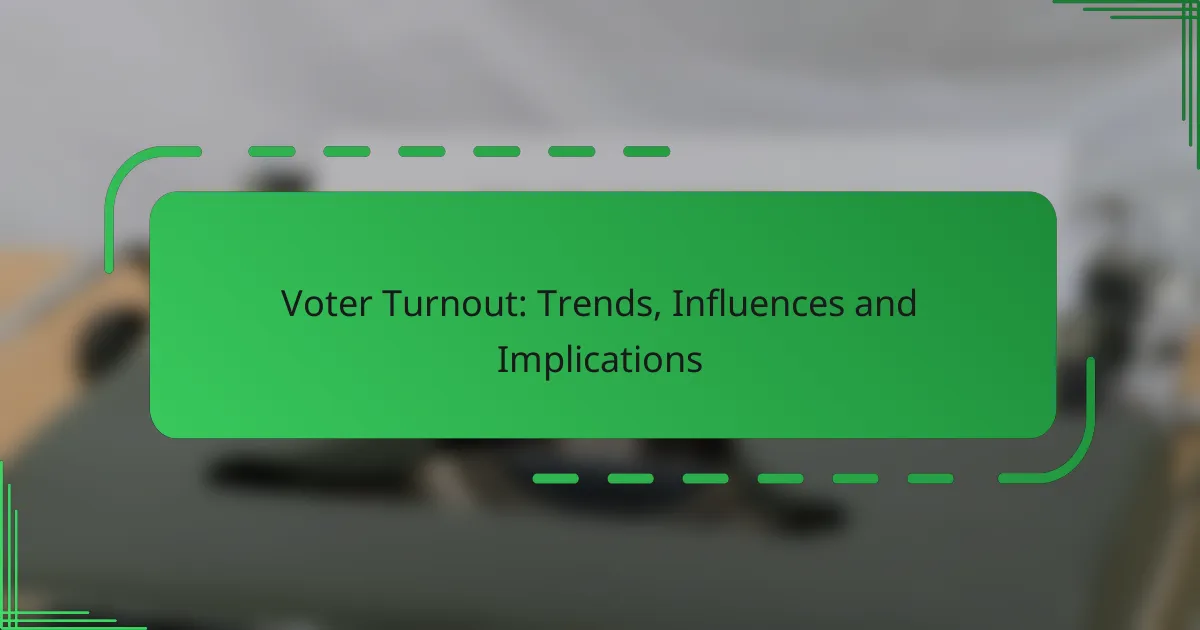Voter turnout is a critical aspect of democratic engagement, influenced by a variety of factors including education, accessibility, and social media. Recent trends indicate that changes in voting laws and demographic shifts play significant roles in shaping participation rates. Low voter turnout can lead to unrepresentative election outcomes, undermining the democratic process and the reflection of citizens’ needs in governance.
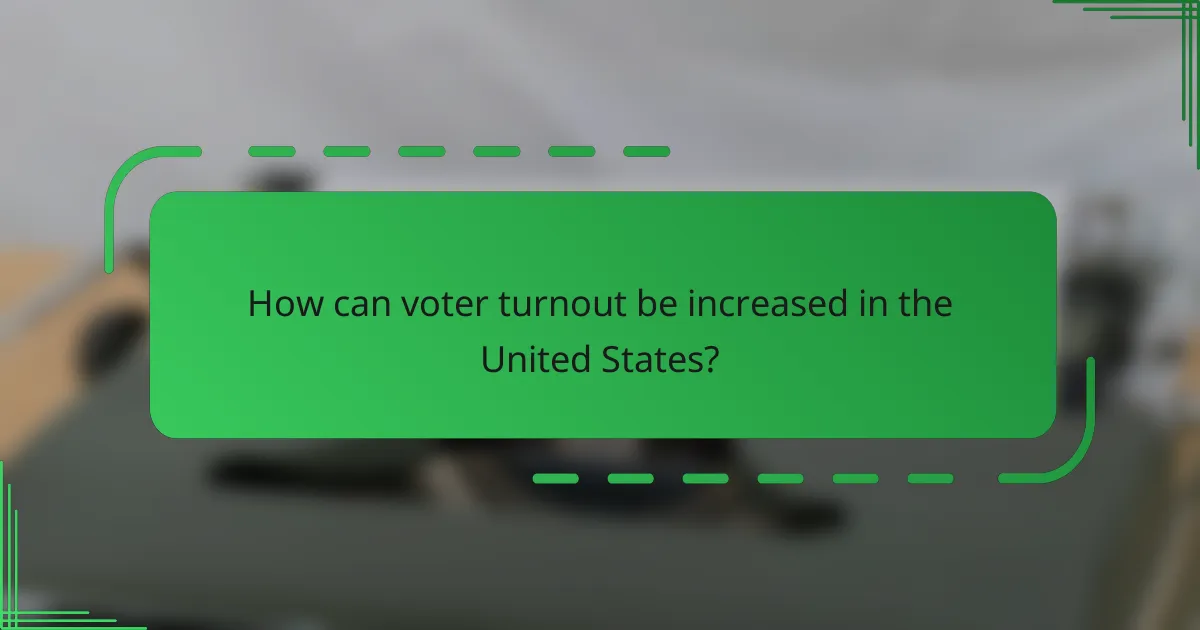
How can voter turnout be increased in the United States?
Increasing voter turnout in the United States can be achieved through various strategies that focus on education, accessibility, and engagement. Implementing effective programs and initiatives can significantly enhance participation rates among eligible voters.
Enhanced voter education programs
Voter education programs are essential for informing citizens about the voting process, including registration, polling locations, and voting methods. These programs can take various forms, such as workshops, online resources, and community events, aimed at demystifying the voting process.
Effective education initiatives should focus on clear communication and accessibility, ensuring that information is available in multiple languages and formats. Collaborating with local organizations can help reach diverse audiences and increase overall awareness.
Improved access to polling places
Improving access to polling places is crucial for facilitating voter participation. This can involve increasing the number of polling locations, extending voting hours, and providing transportation options for those who may have difficulty reaching a polling site.
Additionally, ensuring that polling places are ADA-compliant and equipped to handle high volumes of voters can reduce wait times and enhance the overall voting experience. States can also consider implementing early voting to give citizens more flexibility in casting their ballots.
Same-day registration initiatives
Same-day registration allows voters to register and cast their ballots on the same day, typically during early voting or on Election Day. This approach can significantly boost turnout, particularly among younger voters and those who may have missed registration deadlines.
States that have adopted same-day registration often see increased participation rates, as it removes barriers for those who may have difficulty planning ahead. Implementing this initiative requires clear guidelines and adequate staffing at polling places to assist voters with the registration process.
Targeted outreach to underrepresented communities
Targeted outreach efforts can help engage underrepresented communities, including minorities, low-income individuals, and young voters. Tailoring messages and strategies to resonate with specific groups can enhance their likelihood of participating in elections.
Utilizing social media, community leaders, and local organizations can effectively spread awareness and encourage voter registration. Providing resources in culturally relevant formats and languages can also help ensure that these communities feel included in the electoral process.
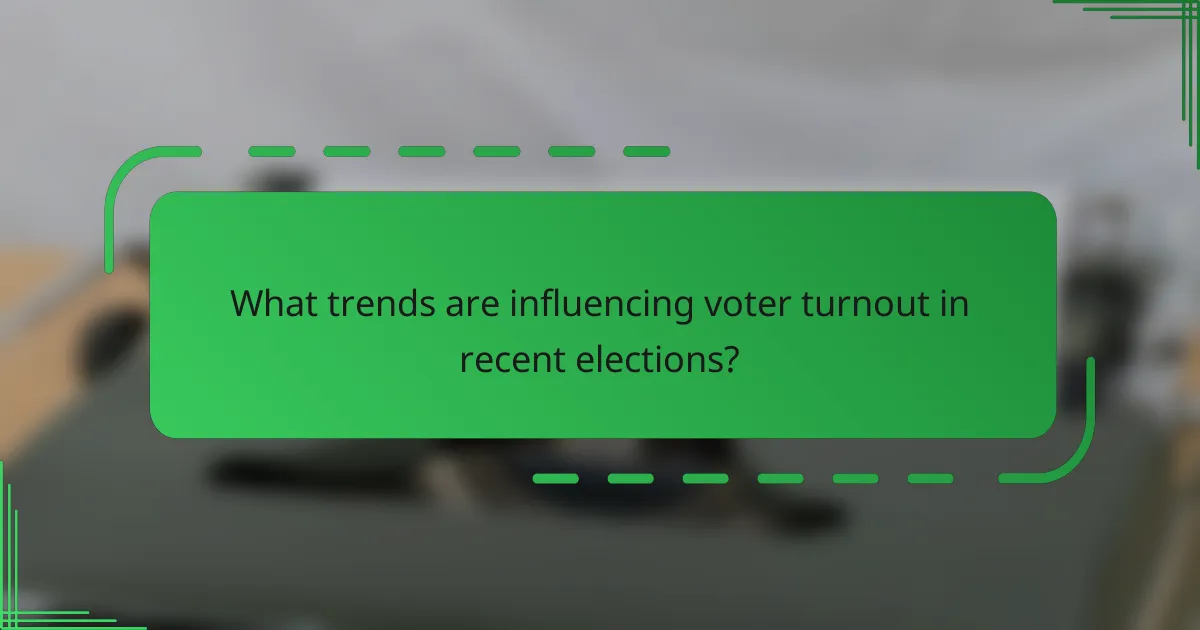
What trends are influencing voter turnout in recent elections?
Recent elections have seen various trends influencing voter turnout, including the rise of social media, changes in voting laws, and shifts in demographic composition. These factors collectively shape how individuals engage with the electoral process and their likelihood of participating in elections.
Impact of social media on voter engagement
Social media has become a powerful tool for voter engagement, allowing candidates and organizations to reach a wide audience quickly. Platforms like Facebook and Twitter facilitate discussions, share information, and mobilize voters, particularly younger demographics who are more active online.
However, social media can also spread misinformation, which may confuse or deter potential voters. It is crucial for users to verify information before acting on it and for platforms to implement measures against false narratives to ensure informed participation.
Changes in voting laws and regulations
Voting laws and regulations significantly impact voter turnout by either facilitating or hindering access to the polls. Recent years have seen various states in the U.S. implement measures such as voter ID laws, mail-in voting options, and early voting periods, which can either encourage or discourage participation.
For instance, states that have expanded mail-in voting and early voting typically see higher turnout rates. Conversely, strict voter ID laws may disproportionately affect marginalized communities, leading to lower participation among those groups.
Demographic shifts in the electorate
Demographic shifts, including changes in age, race, and educational attainment, are influencing voter turnout trends. Younger voters, particularly those from diverse backgrounds, are becoming a more significant part of the electorate, often advocating for issues like climate change and social justice.
As these demographic groups become more engaged, their voting patterns can reshape election outcomes. Understanding these shifts is essential for candidates and parties aiming to connect with and mobilize these voters effectively.
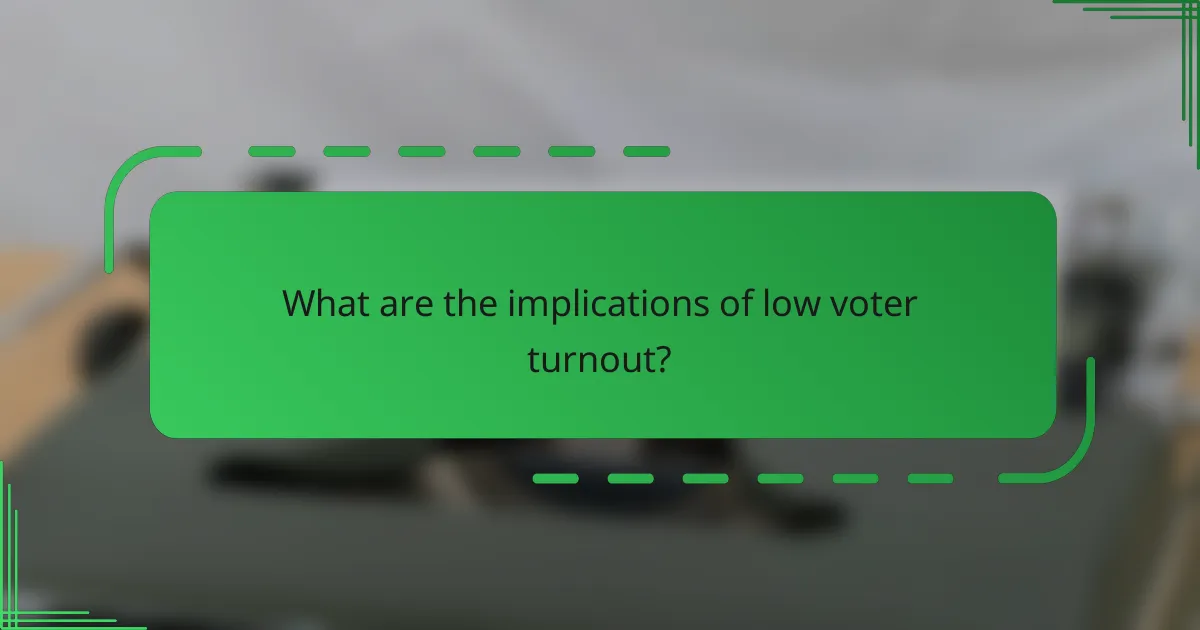
What are the implications of low voter turnout?
Low voter turnout can significantly impact the political landscape, leading to unrepresentative election outcomes and weakened democratic processes. When fewer citizens participate, the elected officials may not reflect the views and needs of the broader population.
Effect on election outcomes
Low voter turnout often skews election results, favoring candidates who appeal to specific demographics rather than the general electorate. For instance, in elections with turnout below 50%, the winning candidate may represent only a fraction of the total eligible voters, undermining the legitimacy of their mandate.
Moreover, lower participation rates can lead to the election of candidates with extreme views, as these individuals may mobilize their supporters more effectively than moderate candidates. This can create a polarized political environment, making bipartisan cooperation more challenging.
Impact on policy decisions
When voter turnout is low, elected officials may prioritize the interests of their core supporters over the needs of the entire community. This can result in policies that do not address pressing issues affecting a larger segment of the population.
Additionally, low participation can lead to a lack of accountability, as officials may feel less compelled to respond to the concerns of constituents who did not vote. This disconnect can perpetuate a cycle of disengagement and dissatisfaction among the electorate.
Consequences for democratic representation
Low voter turnout undermines the principle of representative democracy, as it often results in a government that does not accurately reflect the demographic and ideological diversity of the population. This can lead to policies that marginalize certain groups and fail to address their specific needs.
Furthermore, when significant portions of the population abstain from voting, it diminishes the perceived legitimacy of the electoral process. This can erode public trust in government institutions and discourage future participation, creating a vicious cycle of disengagement.
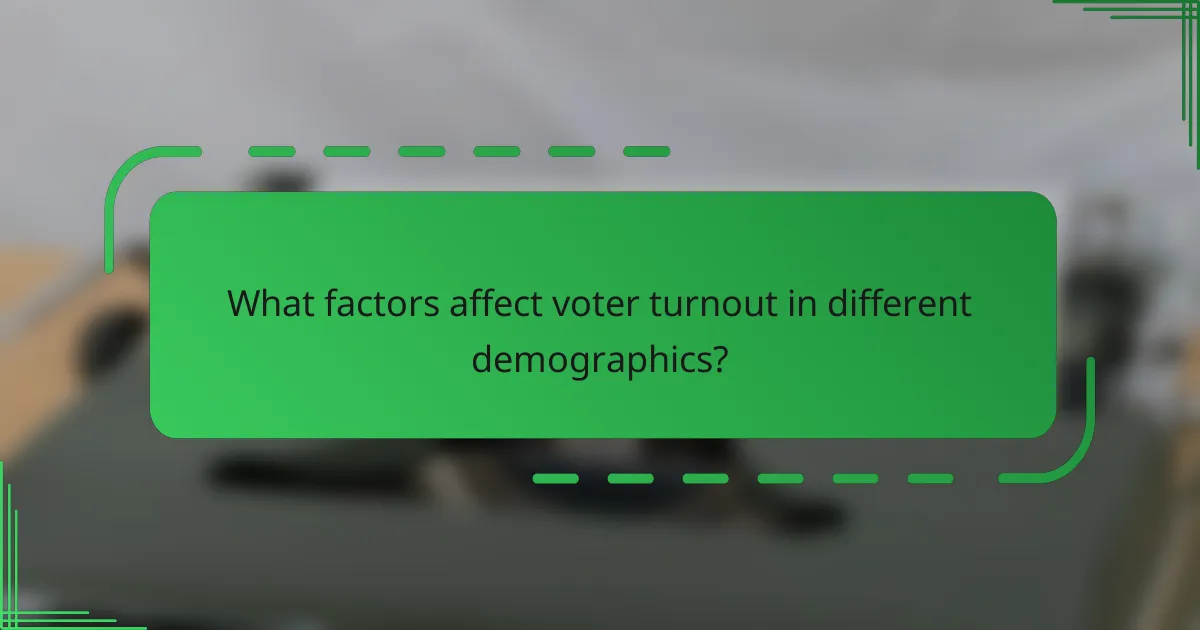
What factors affect voter turnout in different demographics?
Voter turnout is influenced by various factors across different demographics, including age, socioeconomic status, and racial or ethnic backgrounds. Understanding these influences helps in identifying barriers and promoting higher participation rates in elections.
Age-related turnout patterns
Age significantly impacts voter turnout, with younger voters often participating at lower rates compared to older individuals. Typically, those aged 18-24 may see turnout rates in the low twenties to low thirties percent range, while voters aged 65 and older often exceed fifty percent participation.
Efforts to engage younger voters can include targeted outreach through social media and educational initiatives that emphasize the importance of voting. Conversely, older voters may be motivated by issues such as healthcare and retirement security, which can drive higher turnout.
Socioeconomic status influence
Socioeconomic status plays a crucial role in voter turnout, with individuals from higher income brackets generally voting at higher rates than those from lower income backgrounds. Factors such as education level, employment status, and access to resources can create disparities in participation.
For instance, those with a college education may have turnout rates exceeding fifty percent, while those without a high school diploma might see rates drop to the low twenties. Addressing barriers such as transportation and providing information in accessible formats can help improve turnout among lower socioeconomic groups.
Racial and ethnic disparities
Racial and ethnic disparities in voter turnout are evident, with minority groups often facing unique challenges that affect their participation. For example, Black and Hispanic voters may experience lower turnout rates compared to their white counterparts, influenced by factors like voter ID laws and historical disenfranchisement.
Efforts to increase turnout among these groups can include community engagement initiatives, language assistance, and advocacy against restrictive voting laws. Understanding the specific needs and concerns of different racial and ethnic communities is essential for fostering higher electoral participation.
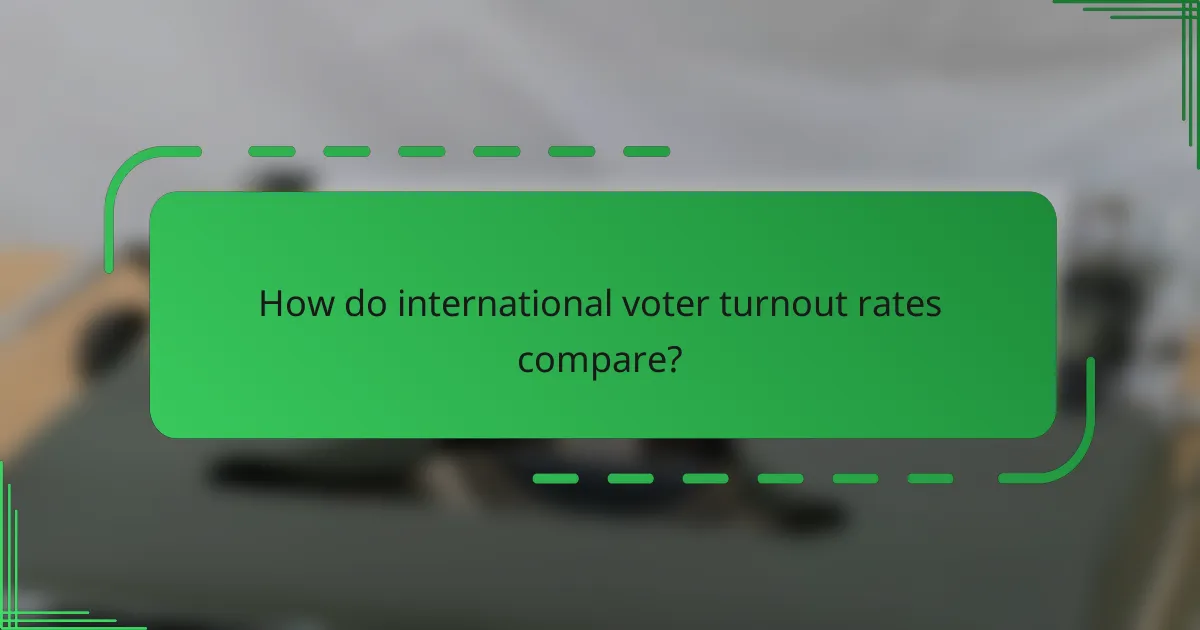
How do international voter turnout rates compare?
International voter turnout rates vary significantly, influenced by factors such as political culture, electoral systems, and public engagement. Generally, countries with compulsory voting laws tend to see higher turnout compared to those where voting is voluntary.
Voter turnout in European countries
European countries exhibit diverse voter turnout rates, often ranging from the low 40s to high 80s percent. Nations like Belgium and Sweden, which have mandatory voting laws, consistently report turnout rates above 80%. In contrast, countries such as Switzerland and the Netherlands see lower participation, often around 50-60% in some elections.
Factors influencing these rates include the political climate, the competitiveness of elections, and the effectiveness of voter outreach programs. For instance, countries with strong civic education initiatives tend to engage more citizens in the electoral process.
Comparison with Asian democracies
Asian democracies present a mixed picture regarding voter turnout, with rates typically ranging from the mid-50s to mid-80s percent. Countries like Japan and South Korea often experience turnout rates in the low 50s, while India, the world’s largest democracy, sees turnout rates around 55-65% in national elections.
Key influences on voter participation in Asia include cultural attitudes towards voting, the perceived legitimacy of electoral processes, and the accessibility of polling places. Countries that actively promote voter education and simplify the voting process tend to achieve higher turnout rates.

What role does technology play in voter turnout?
Technology significantly enhances voter turnout by simplifying the registration process and improving access to information. Tools such as online registration systems and mobile voting applications make it easier for citizens to participate in elections.
Online voter registration systems
Online voter registration systems allow eligible citizens to register to vote via the internet, streamlining the process and reducing barriers. These systems typically require users to provide personal information, such as name, address, and identification details, which are then verified by election officials.
Many countries and states have adopted online registration, leading to increased registration rates. For instance, in the United States, states that offer online registration often see participation rates rise by several percentage points compared to those that do not.
However, it’s essential to ensure that the online systems are secure and user-friendly. Voters should check that their state’s system is up-to-date and accessible, and they should be aware of registration deadlines to avoid last-minute issues.
